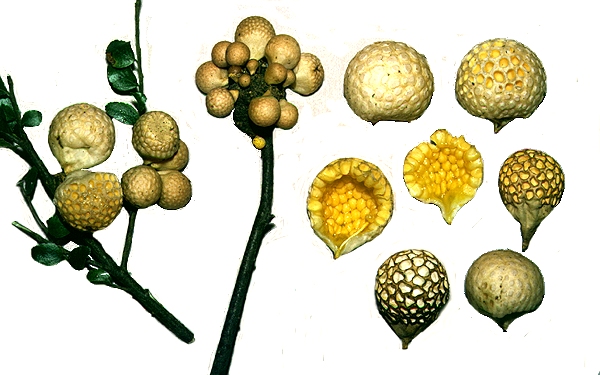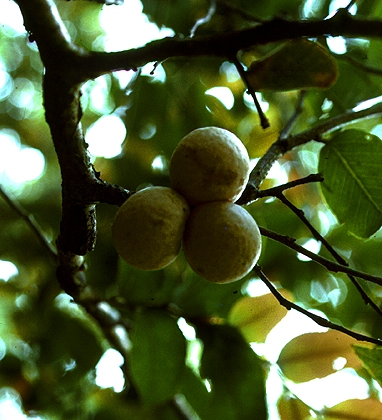
Cyttaria gunnii Berk.

Common name: Beech Orange.
Description: The mature fruiting structures look remarkably like orange golf balls, although when examined closely, they are actually pear-shaped. They are about 24 cm in diameter and at first are protected by a membrane which bursts and shrivels away to disclose the pitted, crater-like fruiting body. The orange structure is actually composed of up to 200 small cups (apothecia) combined in a hollow, compound structure that has a faint smell of apricots. The texture and taste is somewhat gelatinous. The fungal fruiting bodies are formed on the surface of swellings or galls that occur on the branches of the trees.
The spores measure 1113 × 812 µm and are broadly ellipsoidal to subglobose, smooth and black.
Substratum: Cyttaria gunnii is a fungal parasite that only occurs on living trees of Nothofagus spp. (Antarctic Beech and Southern Beech/Myrtle). Galls and fruiting bodies of C. gunnii have been found on N. moorei in Queensland and New South Wales and on N. cunninghamii in Victoria and Tasmania. It is not known if the fungus also occurs on N. gunnii, the deciduous species of beech in Tasmania.
Distribution: Known from Queensland, New South Wales, Victoria and Tasmania. Species of Cyttaria are also found in New Zealand and South America and this distribution pattern supports the theory of continental drift (see section on Gondwana).
Notes: Galls of Cyttaria gunnii that occur on branches are generally more or less harmless to the overall health of the tree, but they can be lethal if they form on the small-diameter main trunk of a sapling. Large galls develop slowly on branches and may fruit for several years. Eventually, the tree walls off the food supply to the branch which then dies and thereby kills the fungus. The internal structure of the galls is quite beautiful when cut and polished. A species of Cyttaria was one of the staple foods of the Tierra del Fuegan Indians in South America and it is still collected for food and sold in markets. It is uncertain if the Australian species has been tested for food. If mature fruiting bodies of Cyttaria gunnii are placed on white paper and left overnight, large numbers of black, radial streaks show where the spores have been discharged from the fruiting bodies.

